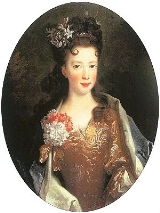
Louisa Maria Teresa Stuart
Encyclopedia
Louisa Maria Teresa Stuart (28 June 1692 – 18 April 1712), known to Jacobites
as The Princess Royal, was the last child of James II and VII
(1633–1701), the deposed king of England, Scotland, and Ireland, and of his queen, Mary of Modena
. In English
, she was called Louisa Maria and Louise Marie in French
.
A Royal Stuart Society
paper calls Louisa Maria the Princess over the Water, an allusion to the informal title King over the Water of the Jacobite pretenders, none of whom had any other legitimate daughters.
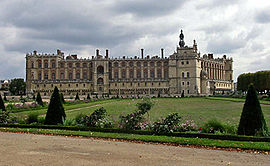 Louisa Maria was born in 1692, at Saint-Germain-en-Laye, during her parents' exile. Due to the huge controversy which had surrounded the birth of her brother, James Francis Edward, with accusations of the substitution of another baby in a warming pan following a still-birth, James II had sent letters inviting not only his daughter, Queen Mary II
Louisa Maria was born in 1692, at Saint-Germain-en-Laye, during her parents' exile. Due to the huge controversy which had surrounded the birth of her brother, James Francis Edward, with accusations of the substitution of another baby in a warming pan following a still-birth, James II had sent letters inviting not only his daughter, Queen Mary II
, to attend the birth in person, but also a large number of other Protestant ladies. Of all her siblings and half-siblings, only her brother James Francis Edward
and her half-sisters, Queen Mary II
and Queen Anne
, survived infancy. Mary died while Louisa Maria was still a small child, but she was on friendly terms with her half-sister Anne.
The Whig
historian Macaulay
later commented on James's precaution:
The new-born princess was given the names Louisa and Maria in baptism
, while Teresa (sometimes spelt Theresa) was added later, at the time of her confirmation. She was given the name Louisa in honour of King Louis XIV, who acted as her godfather. Her godmother was King Louis's sister-in-law, Elizabeth Charlotte, Princess Palatine, Duchess of Orléans.
After the birth, James II declared that Louisa Maria had been sent by God as a consolation for her parents at the time of their distress, and in later years she was often referred to as La Consolatrice.
Louisa's tutor was an English Roman Catholic priest, Father Constable, who taught her Latin
, history, and religion. She also had a governess, the Countess of Middleton, wife of the Jacobite
peer Charles, 2nd Earl of Middleton
. James Drummond, 4th Earl of Perth
, another Jacobite peer living in France, praised the child's natural affability.
An allegorical portrait by Alexis Simon Belle
of James Francis Edward and his sister Louisa Maria, showing the prince as a guardian angel leading his sister under the gaze of cherubim, was painted in 1699 and is now in the Royal Collection
.
By the summer of 1701, King James was seriously ill, and had been away from Saint Germain seeking medical treatment, accompanied by his wife. However, in June the two returned home for the birthdays of their two children, and two months later James suffered a stroke
, dying just two weeks later on 16 September. He was still able to talk when his children visited him for the last time, and to Louisa Maria he said:
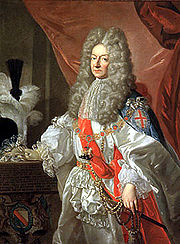 Soon after James's death, Louis XIV proclaimed James Francis Edward as king of England, Scotland and Ireland, and he was also formally recognised as king by Spain
Soon after James's death, Louis XIV proclaimed James Francis Edward as king of England, Scotland and Ireland, and he was also formally recognised as king by Spain
, the Papal States
and Modena
. He and his sister Louisa Maria were transferred to Passy
, into the care of Antoine Nompar de Caumont
and his wife, with Lady Middleton continuing as Louisa Maria's governess there.
In 1705, at the age of thirteen, Louisa Maria was a guest of honour at a ball
at the Château de Marly
, ranking only after Louis XIV himself, her own mother Queen Mary, and her brother James Francis Edward, considered by Louis to be another King.
On 23 March 1708, after a delay caused by the measles
, the young James attempted a landing on Scottish soil, at the Firth of Forth
, supported by a fleet of French ships. However, the force was driven off by a Royal Navy
fleet led by Admiral Byng
.
Louisa Maria enjoyed dancing and the opera, and became popular at the French court. Two possible matches for her were considered, with Louis XIV's grandson Charles, Duke of Berry (1686–1714), and with King Charles XII of Sweden
(1682–1718). Neither took place, the first apparently due to Louisa Maria's equivocal position, and the second because the young King of Sweden was not a Roman Catholic.
Louisa felt keenly that Jacobites in exile had made huge sacrifices for her family, and she herself paid for the daughters of many of them to be educated. In this, she made no distinction between Roman Catholics and Protestants, supporting the daughters of both.
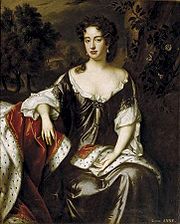 In April 1712, both James Francis Edward and his sister fell sick with smallpox
In April 1712, both James Francis Edward and his sister fell sick with smallpox
. While the Old Pretender recovered, Louisa Maria died on 18 April (8 April, Old Style
) and was buried with her father at the Church of the English Benedictines in Paris
.
A French nobleman wrote of the death of the Princess to a friend at Utrecht:
William Legge, 1st Earl of Dartmouth
, wrote of the Princess's death:
Madame de Maintenon
, the morganatic
second wife of Louis XIV, wrote of Mary of Modena
's reaction to Louisa Maria's death:
In his The History of the Church of Scotland (1845), Thomas Stephen says of the death:
Like many other churches in Paris, the Church of the English Benedictines was desecrated
and vandalised during the French Revolution
. According to Jules Janin, writing in 1844, the remains of Princess Louisa Maria and her father King James II were then resting in the military hospital
of the Val-de-Grâce
.
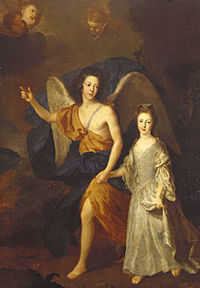 Several portraits of Louisa Maria survive. Among those of Louisa Maria alone, one is by François de Troy
Several portraits of Louisa Maria survive. Among those of Louisa Maria alone, one is by François de Troy
, ca. 1705, while another, painted about 1704, is attributed to Alexis Simon Belle
and is in the National Portrait Gallery, London
. Also in the National Portrait Gallery is a portrait painted in 1695 by Nicolas de Largillière
of Louisa Maria with her brother James Francis Edward. This was engraved as a mezzotint
by John Smith and published in 1699. Another portrait of Louisa Maria with her brother, depicting him as an angel
, is in the Royal Collection
and is again attributed to Belle. A portrait with a cavalier King Charles spaniel
was engraved as a mezzotint by Bernard Lens II
and published c. 1700.
's picaresque novel
The Fortunate Foundlings (1744). Haywood says of Louisa:
, Louise-Marie-Thérèse) were later used for Luisa Maria Teresa of Parma
(1751–1819), Queen consort of Charles IV of Spain
, for Louise Marie Thérèse of France, the eldest daughter of Charles Ferdinand, Duke of Berry, born 1819, and for Louise Marie Thérèse Charlotte Isabelle of Orléans, daughter of King Louis-Philippe of France
and the Queen of King Leopold I of Belgium
.
Sources:
Jacobitism
Jacobitism was the political movement in Britain dedicated to the restoration of the Stuart kings to the thrones of England, Scotland, later the Kingdom of Great Britain, and the Kingdom of Ireland...
as The Princess Royal, was the last child of James II and VII
James II of England
James II & VII was King of England and King of Ireland as James II and King of Scotland as James VII, from 6 February 1685. He was the last Catholic monarch to reign over the Kingdoms of England, Scotland, and Ireland...
(1633–1701), the deposed king of England, Scotland, and Ireland, and of his queen, Mary of Modena
Mary of Modena
Mary of Modena was Queen consort of England, Scotland and Ireland as the second wife of King James II and VII. A devout Catholic, Mary became, in 1673, the second wife of James, Duke of York, who later succeeded his older brother Charles II as King James II...
. In English
English language
English is a West Germanic language that arose in the Anglo-Saxon kingdoms of England and spread into what was to become south-east Scotland under the influence of the Anglian medieval kingdom of Northumbria...
, she was called Louisa Maria and Louise Marie in French
French language
French is a Romance language spoken as a first language in France, the Romandy region in Switzerland, Wallonia and Brussels in Belgium, Monaco, the regions of Quebec and Acadia in Canada, and by various communities elsewhere. Second-language speakers of French are distributed throughout many parts...
.
A Royal Stuart Society
Royal Stuart Society
The Royal Stuart Society, founded in 1926, is the senior monarchist organisation and the foremost Jacobite and Legitimist body in the United Kingdom...
paper calls Louisa Maria the Princess over the Water, an allusion to the informal title King over the Water of the Jacobite pretenders, none of whom had any other legitimate daughters.
Birth

Mary II of England
Mary II was joint Sovereign of England, Scotland, and Ireland with her husband and first cousin, William III and II, from 1689 until her death. William and Mary, both Protestants, became king and queen regnant, respectively, following the Glorious Revolution, which resulted in the deposition of...
, to attend the birth in person, but also a large number of other Protestant ladies. Of all her siblings and half-siblings, only her brother James Francis Edward
James Francis Edward Stuart
James Francis Edward, Prince of Wales was the son of the deposed James II of England...
and her half-sisters, Queen Mary II
Mary II of England
Mary II was joint Sovereign of England, Scotland, and Ireland with her husband and first cousin, William III and II, from 1689 until her death. William and Mary, both Protestants, became king and queen regnant, respectively, following the Glorious Revolution, which resulted in the deposition of...
and Queen Anne
Anne of Great Britain
Anne ascended the thrones of England, Scotland and Ireland on 8 March 1702. On 1 May 1707, under the Act of Union, two of her realms, England and Scotland, were united as a single sovereign state, the Kingdom of Great Britain.Anne's Catholic father, James II and VII, was deposed during the...
, survived infancy. Mary died while Louisa Maria was still a small child, but she was on friendly terms with her half-sister Anne.
The Whig
British Whig Party
The Whigs were a party in the Parliament of England, Parliament of Great Britain, and Parliament of the United Kingdom, who contested power with the rival Tories from the 1680s to the 1850s. The Whigs' origin lay in constitutional monarchism and opposition to absolute rule...
historian Macaulay
Thomas Babington Macaulay, 1st Baron Macaulay
Thomas Babington Macaulay, 1st Baron Macaulay PC was a British poet, historian and Whig politician. He wrote extensively as an essayist and reviewer, and on British history...
later commented on James's precaution:
The new-born princess was given the names Louisa and Maria in baptism
Baptism
In Christianity, baptism is for the majority the rite of admission , almost invariably with the use of water, into the Christian Church generally and also membership of a particular church tradition...
, while Teresa (sometimes spelt Theresa) was added later, at the time of her confirmation. She was given the name Louisa in honour of King Louis XIV, who acted as her godfather. Her godmother was King Louis's sister-in-law, Elizabeth Charlotte, Princess Palatine, Duchess of Orléans.
After the birth, James II declared that Louisa Maria had been sent by God as a consolation for her parents at the time of their distress, and in later years she was often referred to as La Consolatrice.
Life
Louisa was the only full sibling of Prince James Francis Edward, the 'Old Pretender', to survive infancy, and was four years younger than her brother. The two were brought up together in France.Louisa's tutor was an English Roman Catholic priest, Father Constable, who taught her Latin
Latin
Latin is an Italic language originally spoken in Latium and Ancient Rome. It, along with most European languages, is a descendant of the ancient Proto-Indo-European language. Although it is considered a dead language, a number of scholars and members of the Christian clergy speak it fluently, and...
, history, and religion. She also had a governess, the Countess of Middleton, wife of the Jacobite
Jacobitism
Jacobitism was the political movement in Britain dedicated to the restoration of the Stuart kings to the thrones of England, Scotland, later the Kingdom of Great Britain, and the Kingdom of Ireland...
peer Charles, 2nd Earl of Middleton
Charles Middleton, 2nd Earl of Middleton
Charles Middleton, 2nd Earl of Middleton, Jacobite 1st Earl of Monmouth, PC was a Scottish and English politician who held several offices under Charles II and James II & VI...
. James Drummond, 4th Earl of Perth
James Drummond, 4th Earl of Perth
James Drummond, 1st Duke of Perth KT PC , also 4th Earl of Perth and 7th Lord Drummond, was a Scottish statesman, and Jacobite.-Family:...
, another Jacobite peer living in France, praised the child's natural affability.
An allegorical portrait by Alexis Simon Belle
Alexis Simon Belle
Alexis Simon Belle was a French portrait painter, known for his portraits of the French and Jacobite nobility.-Birth:...
of James Francis Edward and his sister Louisa Maria, showing the prince as a guardian angel leading his sister under the gaze of cherubim, was painted in 1699 and is now in the Royal Collection
Royal Collection
The Royal Collection is the art collection of the British Royal Family. It is property of the monarch as sovereign, but is held in trust for her successors and the nation. It contains over 7,000 paintings, 40,000 watercolours and drawings, and about 150,000 old master prints, as well as historical...
.
By the summer of 1701, King James was seriously ill, and had been away from Saint Germain seeking medical treatment, accompanied by his wife. However, in June the two returned home for the birthdays of their two children, and two months later James suffered a stroke
Stroke
A stroke, previously known medically as a cerebrovascular accident , is the rapidly developing loss of brain function due to disturbance in the blood supply to the brain. This can be due to ischemia caused by blockage , or a hemorrhage...
, dying just two weeks later on 16 September. He was still able to talk when his children visited him for the last time, and to Louisa Maria he said:

Enlightenment Spain
The Age of Enlightenment came to Spain in the eighteenth century with a new Bourbon dynasty after the decay of the Spanish economy, bureaucracy, and empire in the latter years of the former Habsburg dynasty...
, the Papal States
Papal States
The Papal State, State of the Church, or Pontifical States were among the major historical states of Italy from roughly the 6th century until the Italian peninsula was unified in 1861 by the Kingdom of Piedmont-Sardinia .The Papal States comprised territories under...
and Modena
Modena
Modena is a city and comune on the south side of the Po Valley, in the Province of Modena in the Emilia-Romagna region of Italy....
. He and his sister Louisa Maria were transferred to Passy
Passy
Passy is an area of Paris, France, located in the XVIe arrondissement, on the Right Bank. It is traditionally home to many of the city's wealthiest residents.Passy was formerly a commune...
, into the care of Antoine Nompar de Caumont
Antoine Nompar de Caumont
Antoine Nompar de Caumont, marquis de Puyguilhem, duc de Lauzun was a French courtier and soldier. He was the only love interest of the "greatest heiress in Europe", Anne Marie Louise d'Orléans, cousin of Louis XIV.-Biography:...
and his wife, with Lady Middleton continuing as Louisa Maria's governess there.
In 1705, at the age of thirteen, Louisa Maria was a guest of honour at a ball
Ball (dance)
A ball is a formal dance. The word 'ball' is derived from the Latin word "ballare", meaning 'to dance'; the term also derived into "bailar", which is the Spanish and Portuguese word for dance . In Catalan it is the same word, 'ball', for the dance event.Attendees wear evening attire, which is...
at the Château de Marly
Château de Marly
The Château de Marly was a relatively small French royal residence located in what has become Marly-le-Roi, the commune that existed at the edge of the royal park. The town that originally grew up to service the château is now a dormitory community for Paris....
, ranking only after Louis XIV himself, her own mother Queen Mary, and her brother James Francis Edward, considered by Louis to be another King.
On 23 March 1708, after a delay caused by the measles
Measles
Measles, also known as rubeola or morbilli, is an infection of the respiratory system caused by a virus, specifically a paramyxovirus of the genus Morbillivirus. Morbilliviruses, like other paramyxoviruses, are enveloped, single-stranded, negative-sense RNA viruses...
, the young James attempted a landing on Scottish soil, at the Firth of Forth
Firth of Forth
The Firth of Forth is the estuary or firth of Scotland's River Forth, where it flows into the North Sea, between Fife to the north, and West Lothian, the City of Edinburgh and East Lothian to the south...
, supported by a fleet of French ships. However, the force was driven off by a Royal Navy
Royal Navy
The Royal Navy is the naval warfare service branch of the British Armed Forces. Founded in the 16th century, it is the oldest service branch and is known as the Senior Service...
fleet led by Admiral Byng
George Byng, 1st Viscount Torrington
Admiral of the Fleet George Byng, 1st Viscount Torrington, KB PC was a British naval officer and statesman of the late 17th and early 18th centuries. His career included service as First Lord of the Admiralty during the reign of King George II.-Naval career:Byng was born at Wrotham, Kent, England...
.
Louisa Maria enjoyed dancing and the opera, and became popular at the French court. Two possible matches for her were considered, with Louis XIV's grandson Charles, Duke of Berry (1686–1714), and with King Charles XII of Sweden
Charles XII of Sweden
Charles XII also Carl of Sweden, , Latinized to Carolus Rex, Turkish: Demirbaş Şarl, also known as Charles the Habitué was the King of the Swedish Empire from 1697 to 1718...
(1682–1718). Neither took place, the first apparently due to Louisa Maria's equivocal position, and the second because the young King of Sweden was not a Roman Catholic.
Louisa felt keenly that Jacobites in exile had made huge sacrifices for her family, and she herself paid for the daughters of many of them to be educated. In this, she made no distinction between Roman Catholics and Protestants, supporting the daughters of both.
Death

Smallpox
Smallpox was an infectious disease unique to humans, caused by either of two virus variants, Variola major and Variola minor. The disease is also known by the Latin names Variola or Variola vera, which is a derivative of the Latin varius, meaning "spotted", or varus, meaning "pimple"...
. While the Old Pretender recovered, Louisa Maria died on 18 April (8 April, Old Style
Old Style and New Style dates
Old Style and New Style are used in English language historical studies either to indicate that the start of the Julian year has been adjusted to start on 1 January even though documents written at the time use a different start of year ; or to indicate that a date conforms to the Julian...
) and was buried with her father at the Church of the English Benedictines in Paris
Paris
Paris is the capital and largest city in France, situated on the river Seine, in northern France, at the heart of the Île-de-France region...
.
A French nobleman wrote of the death of the Princess to a friend at Utrecht:
William Legge, 1st Earl of Dartmouth
William Legge, 1st Earl of Dartmouth
William Legge, 1st Earl of Dartmouth , only son of George Legge, 1st Baron Dartmouth, succeeded to his father's barony in 1691. In 1702 he was appointed a member of the Board of Trade and Plantations, and eight years later he became Secretary of State for the Southern Department and joint keeper of...
, wrote of the Princess's death:
Madame de Maintenon
Françoise d'Aubigné, Marquise de Maintenon
Françoise d'Aubigné, Marquise de Maintenon was the second wife of King Louis XIV of France. She was known during her first marriage as Madame Scarron, and subsequently as Madame de Maintenon...
, the morganatic
Morganatic marriage
In the context of European royalty, a morganatic marriage is a marriage between people of unequal social rank, which prevents the passage of the husband's titles and privileges to the wife and any children born of the marriage...
second wife of Louis XIV, wrote of Mary of Modena
Mary of Modena
Mary of Modena was Queen consort of England, Scotland and Ireland as the second wife of King James II and VII. A devout Catholic, Mary became, in 1673, the second wife of James, Duke of York, who later succeeded his older brother Charles II as King James II...
's reaction to Louisa Maria's death:
In his The History of the Church of Scotland (1845), Thomas Stephen says of the death:
Like many other churches in Paris, the Church of the English Benedictines was desecrated
Desecration
Desecration is the act of depriving something of its sacred character, or the disrespectful or contemptuous treatment of that which is held to be sacred or holy by a group or individual.-Detail:...
and vandalised during the French Revolution
French Revolution
The French Revolution , sometimes distinguished as the 'Great French Revolution' , was a period of radical social and political upheaval in France and Europe. The absolute monarchy that had ruled France for centuries collapsed in three years...
. According to Jules Janin, writing in 1844, the remains of Princess Louisa Maria and her father King James II were then resting in the military hospital
Military hospital
Military hospital is a hospital, which is generally located on a military base and is reserved for the use of military personnel, their dependents or other authorized users....
of the Val-de-Grâce
Val-de-Grâce
This article describes the hospital and former abbey. For the main article on Mansart and Lemercier's central church, see Church of the Val-de-Grâce....
.
Portraits

François de Troy
François de Troy was a French painter and engraver who became principal painter to King James II in exile at Saint-Germain-en-Laye and Director of the Académie Royale de peinture et de sculpture.-Early life:...
, ca. 1705, while another, painted about 1704, is attributed to Alexis Simon Belle
Alexis Simon Belle
Alexis Simon Belle was a French portrait painter, known for his portraits of the French and Jacobite nobility.-Birth:...
and is in the National Portrait Gallery, London
London
London is the capital city of :England and the :United Kingdom, the largest metropolitan area in the United Kingdom, and the largest urban zone in the European Union by most measures. Located on the River Thames, London has been a major settlement for two millennia, its history going back to its...
. Also in the National Portrait Gallery is a portrait painted in 1695 by Nicolas de Largillière
Nicolas de Largillière
Nicolas de Largillière was a painter born in Paris, France.-Early life:Largillière's father, a merchant, took him to Antwerp at the age of three. As a boy, he spent nearly two years in London. Sometime after his return to Antwerp, a failed attempt at business led him to the studio of Goubeau...
of Louisa Maria with her brother James Francis Edward. This was engraved as a mezzotint
Mezzotint
Mezzotint is a printmaking process of the intaglio family, technically a drypoint method. It was the first tonal method to be used, enabling half-tones to be produced without using line- or dot-based techniques like hatching, cross-hatching or stipple...
by John Smith and published in 1699. Another portrait of Louisa Maria with her brother, depicting him as an angel
Angel
Angels are mythical beings often depicted as messengers of God in the Hebrew and Christian Bibles along with the Quran. The English word angel is derived from the Greek ἄγγελος, a translation of in the Hebrew Bible ; a similar term, ملائكة , is used in the Qur'an...
, is in the Royal Collection
Royal Collection
The Royal Collection is the art collection of the British Royal Family. It is property of the monarch as sovereign, but is held in trust for her successors and the nation. It contains over 7,000 paintings, 40,000 watercolours and drawings, and about 150,000 old master prints, as well as historical...
and is again attributed to Belle. A portrait with a cavalier King Charles spaniel
Cavalier King Charles Spaniel
The Cavalier King Charles Spaniel is a small breed of Spaniel-type dog, and is classed as a toy dog by most kennel clubs. It is one of the most popular breeds in the United Kingdom. Since 2000, it has been growing in popularity in the United States. It is a smaller breed of spaniel, and Cavalier...
was engraved as a mezzotint by Bernard Lens II
Bernard Lens II
Bernard Lens II was an English engraver, pioneer of mezzotint technique, and publisher.Bernard Lens II was the son of the first Bernard Lens, "an obscure painter" of Dutch origin...
and published c. 1700.
In fiction
Princess Louisa appears at the age of twelve in Eliza HaywoodEliza Haywood
Eliza Haywood , born Elizabeth Fowler, was an English writer, actress and publisher. Since the 1980s, Eliza Haywood’s literary works have been gaining in recognition and interest...
's picaresque novel
Picaresque novel
The picaresque novel is a popular sub-genre of prose fiction which is usually satirical and depicts, in realistic and often humorous detail, the adventures of a roguish hero of low social class who lives by his wits in a corrupt society...
The Fortunate Foundlings (1744). Haywood says of Louisa:
Namesakes
The names Louisa Maria Teresa (in FrenchFrench language
French is a Romance language spoken as a first language in France, the Romandy region in Switzerland, Wallonia and Brussels in Belgium, Monaco, the regions of Quebec and Acadia in Canada, and by various communities elsewhere. Second-language speakers of French are distributed throughout many parts...
, Louise-Marie-Thérèse) were later used for Luisa Maria Teresa of Parma
Maria Luisa of Parma
Maria Luisa of Parma was Queen consort of Spain from 1788 to 1808 as the wife of King Charles IV of Spain. She was the youngest daughter of Duke Philip of Parma and his wife, Louise-Élisabeth of France, the eldest daughter of King Louis XV.She was christened Luisa Maria Teresa Ana, but was known...
(1751–1819), Queen consort of Charles IV of Spain
Charles IV of Spain
Charles IV was King of Spain from 14 December 1788 until his abdication on 19 March 1808.-Early life:...
, for Louise Marie Thérèse of France, the eldest daughter of Charles Ferdinand, Duke of Berry, born 1819, and for Louise Marie Thérèse Charlotte Isabelle of Orléans, daughter of King Louis-Philippe of France
Louis-Philippe of France
Louis Philippe I was King of the French from 1830 to 1848 in what was known as the July Monarchy. His father was a duke who supported the French Revolution but was nevertheless guillotined. Louis Philippe fled France as a young man and spent 21 years in exile, including considerable time in the...
and the Queen of King Leopold I of Belgium
Leopold I of Belgium
Leopold I was from 21 July 1831 the first King of the Belgians, following Belgium's independence from the Netherlands. He was the founder of the Belgian line of the House of Saxe-Coburg-Gotha...
.
Ancestry
Sources:
- Ancestors of Louisa Maria Theresa, Princess of England, Scotland and Ireland at worldroots.com
- Addington, A. C., The Royal House of Stuart (London, 1969, third edition 1976)
See also
- JacobitismJacobitismJacobitism was the political movement in Britain dedicated to the restoration of the Stuart kings to the thrones of England, Scotland, later the Kingdom of Great Britain, and the Kingdom of Ireland...
- Act of Settlement 1701Act of Settlement 1701The Act of Settlement is an act of the Parliament of England that was passed in 1701 to settle the succession to the English throne on the Electress Sophia of Hanover and her Protestant heirs. The act was later extended to Scotland, as a result of the Treaty of Union , enacted in the Acts of Union...
- Correspondence with James the Pretender (High Treason) Act 1701Correspondence with James the Pretender (High Treason) Act 1701The Correspondence with James the Pretender Act 1701 was an Act of Parliament of the Parliament of England passed in 1701. The long title of the Act is "An Act for the Attainder of the pretended Prince of Wales of High Treason"...
- Monument to the Royal StuartsMonument to the Royal StuartsThe Monument to the Royal Stuarts is a memorial in St. Peter's Basilica, in the Vatican in Rome. It commemorates the last three members of the Royal House of Stuart: James Francis Edward Stuart, his elder son Charles Edward Stuart, and his younger son, Henry Benedict Stuart...
External links
- Portraits of Princess Louisa Maria Theresa Stuart at the web site of the National Portrait Gallery
- Louisa Maria Theresa Stuart at thepeerage.com

